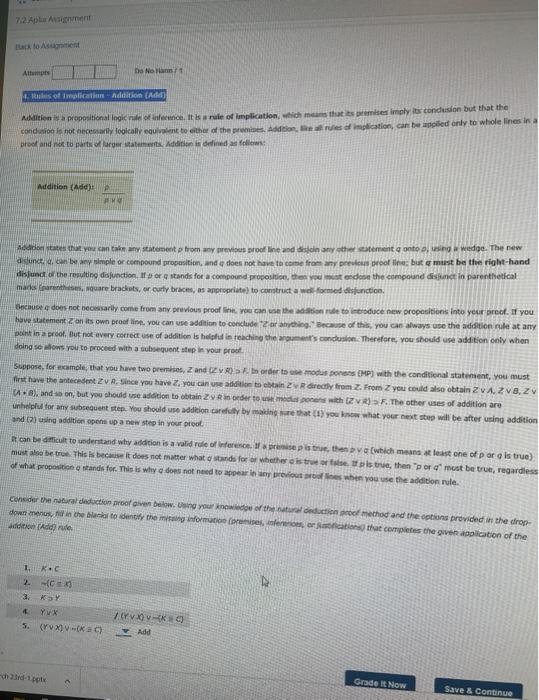7.2 Apl Art Alumas De Not sol implication - Addition (Add Addition des propositional ingicule finference. It is rule of implication, which means that premier ply-conclusion but that the condusion is not necessarily logically equivat tether of the premises. Addition rules of implication, can be applied only to whole lines in a pro and not to parts of larger statements Addition is defined as follows: Addition (Add Adonates that you can take any statement from any previous proof line and on any other statement onto , using a wedge. The new didunct. d. can be any simple or compound proposition, and does not have to come from any plus proof line; but a must be the right-hand disjunct of the resulting disfunction. If og stands for a compound proposition, then you done the compound disc in parenthetical manier, quare brackets, or curly braces, as appropriate to constructa formed sjunction Because does not necessarily come from any previous proof you can there to introduce new propositions into your proof. If you hove statement on its own proof line. You can use addition to conclude or anything. Because of this, you can always use the addition rule at any on in a roof, but not every correct use of addition is helpful in teaching the argument's condusion. Therefore, you should use addition only when doing so wows you to proceed with a subsequent step in your proot Suppo, for example, that you have two premises, and border to use mod poros CMP) with the conditional statement, you must first have the antecedent v A. Since you have you can use addition to in directly from Z. From Z you could also obtain ZVA 28. Zv ..and so on, but you should use addition to obtain Zy in order to me with Z. The other uses of addition are unhelpful for any subsequent step. You should use addition carefully by making that (1) you know what your next step will be after using addition and using addition opens up a new step in your root It can be difficult to understand why addition is a valid rule ofference. 1 spise is the theme which means at one of por is true) must also be true. This is because it does not matter what stands for or whether is tropis true then porcmust be true, regardless of what proposition stands for. This is why does not need to appear in my previous when you use the addition rule. Consider the natural deduction proven below. Your of the londuction of method and the options provided in the drop downs, de the band to dentify the mindormacion premises on the completes the given application of the idon Add rule 1 K. 2. *Y Yv.XO-K ) 5. (Yv-ko A -chd- Grade It Now Save & Continue 7.2 Apl Art Alumas De Not sol implication - Addition (Add Addition des propositional ingicule finference. It is rule of implication, which means that premier ply-conclusion but that the condusion is not necessarily logically equivat tether of the premises. Addition rules of implication, can be applied only to whole lines in a pro and not to parts of larger statements Addition is defined as follows: Addition (Add Adonates that you can take any statement from any previous proof line and on any other statement onto , using a wedge. The new didunct. d. can be any simple or compound proposition, and does not have to come from any plus proof line; but a must be the right-hand disjunct of the resulting disfunction. If og stands for a compound proposition, then you done the compound disc in parenthetical manier, quare brackets, or curly braces, as appropriate to constructa formed sjunction Because does not necessarily come from any previous proof you can there to introduce new propositions into your proof. If you hove statement on its own proof line. You can use addition to conclude or anything. Because of this, you can always use the addition rule at any on in a roof, but not every correct use of addition is helpful in teaching the argument's condusion. Therefore, you should use addition only when doing so wows you to proceed with a subsequent step in your proot Suppo, for example, that you have two premises, and border to use mod poros CMP) with the conditional statement, you must first have the antecedent v A. Since you have you can use addition to in directly from Z. From Z you could also obtain ZVA 28. Zv ..and so on, but you should use addition to obtain Zy in order to me with Z. The other uses of addition are unhelpful for any subsequent step. You should use addition carefully by making that (1) you know what your next step will be after using addition and using addition opens up a new step in your root It can be difficult to understand why addition is a valid rule ofference. 1 spise is the theme which means at one of por is true) must also be true. This is because it does not matter what stands for or whether is tropis true then porcmust be true, regardless of what proposition stands for. This is why does not need to appear in my previous when you use the addition rule. Consider the natural deduction proven below. Your of the londuction of method and the options provided in the drop downs, de the band to dentify the mindormacion premises on the completes the given application of the idon Add rule 1 K. 2. *Y Yv.XO-K ) 5. (Yv-ko A -chd- Grade It Now Save & Continue







